Surely if you have the slightest interest in handmade/DIY/craft culture, you saw the NYT’s big story about how the category is faring in the downturn:
Craft stores, from giant chains like Michaels Stores to small scrapbook supply shops, are reporting that sales are higher compared with the last holiday season, and online marketplaces for handmade goods, like Etsy, are seeing a boom in listings and transactions.
Handmade/craft was also the theme on KCRW’s Design And Architecture this past weekend. (In an amusing moment, host Frances Anderton alluded to the same theme as that Times article while interviewing the creative director of Heath Ceramics: There’s all this unemployment and other bad economic news, Anderton obesrved, “And yet this store is a massive vote of confidence, it seems, in people’s ability to keep on buying nice ceramics.”)
Earlier Murketing noted that Etsy’s sales have been resilient. And I don’t think this broad story is going to go away anytime soon. I of course have a chapter on the crafty scene in Buying In, covering Etsy to some extent as well the Austin Craft Mafia and others.
Although I just poked fun at Anderton’s bit about “the ability to keep on buying nice ceramics,” the person from Heath actually had a response that is pretty much on point regarding the bigger question of why this segment may be holding up better than others: Some consumers still want special things, things with a narrative to them; and the handmade world feels distinct from the big-corporate world that some consumers have lost trust in.
There are different ways to assess the alternative vision of material culture that the handmade scene may or may not be offering us — but I don’t want to rehash the book here. Suffice it to say the questions are compelling enough, I believe, that they’ll stick with us in the year ahead, and more and more people are going to be interested in those questions, and their potential answers. I noticed recently that even Advertising Age is paying attention, having rounded up Etsy founder Robert Kalin as a speaker at its Idea Conference. In all, the subject seems to have made its way onto the mainstream radar in a new way in 2008. And next year the Handmade Nation documentary will come out and will likely bring even more attention to the scene.
It should be interesting to watch.
[If you simply refuse to read Buying In, here’s the Handmade 2.0 article I wrote for the Times Magazine; here’s a series of Q&As I did with three of the Austin Craft Mafia’s founders when the book came out; here’s a link to explore all the DIYism posts on this site; and here’s a link to all my DIYism-related Delicious links.]
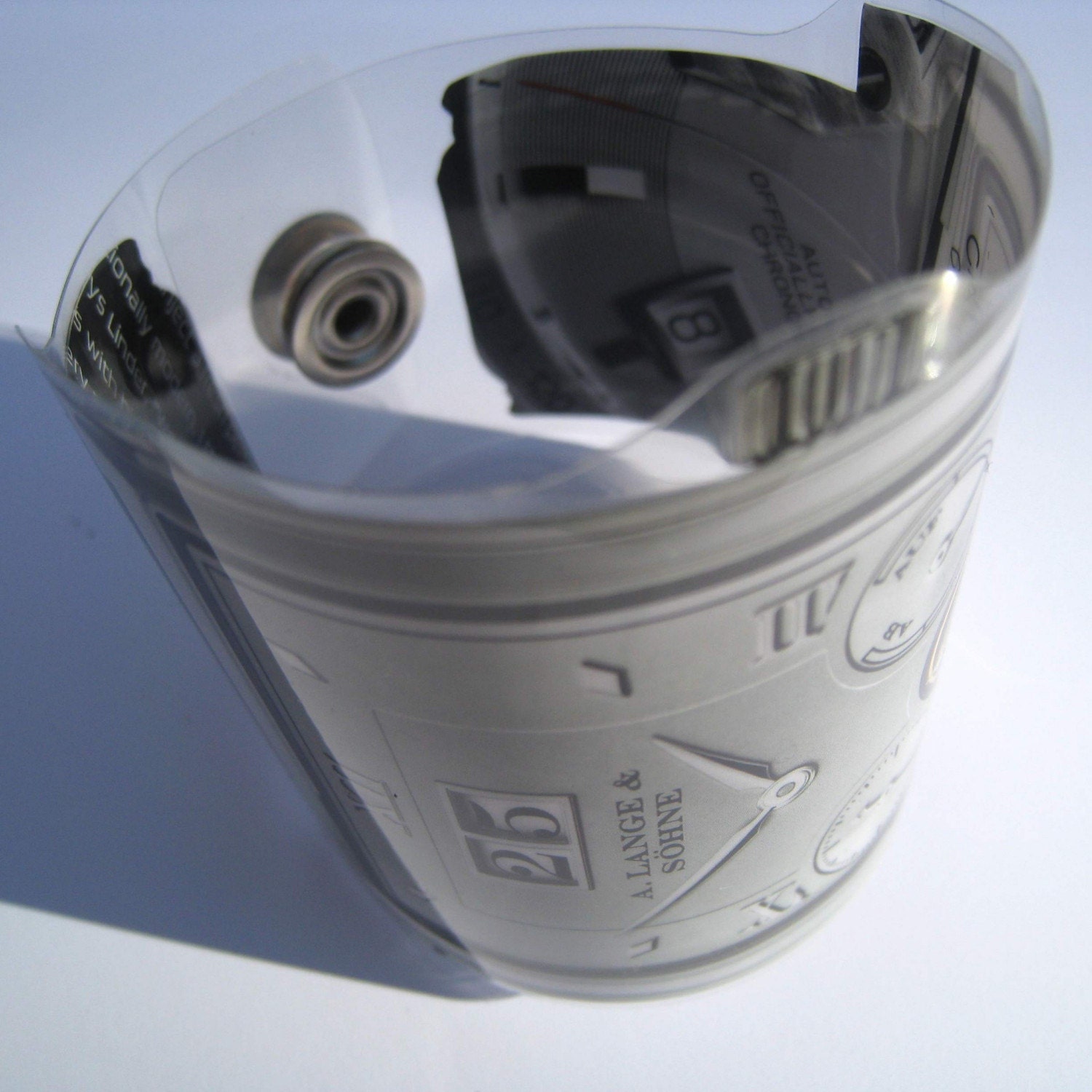
Here’s the latest chapter in my ongoing coverage of counterfunctional watches — meaning watches that do a bad job telling you what time it is, or no job at all, but have some kind of other aesthetic and/or identity payoff (see related Consumed; related Murketing posts; related links):
It took me a minute to figure out what was going on here, but Etsy seller belleslettres‘ Fake Watch Collection is made of magazine images of watches, laminated, with a snap closure. It’s a wearable picture of a watch. Obviously they don’t tell time, but at $15 or so, are cheaper than the real-world Rolexes and so on that they depict.
Via The Storque.
The resurgence of the handmade movement under the banner “This isn’t your grandma’s …” has left some seasoned crafters with mixed emotions. “On the one hand, when I first heard it, I knew exactly what they meant, so that is a good thing for marketing,” [Boston-based doll artist Mimi] Kirchner says. “But it got old really fast. Now it sounds like the slogan of people who have no idea what the history of craft in America is all about.”
True, most of what’s considered hip in the craft world these days isn’t what our grandmothers were doing. But the roots of today’s craft brilliance grow in the rich soil toiled by our grandmothers.
Good point. The rest is here.
We keep this in the car. When we have to park at a meter downtown, as E points out, this is the change we need.
[Bonus! DIY instructions to make your own Obama “change” jar: 1. Google around for an Obama “change” image. 2. Print it out on sticker paper, at the appropriate size. 3. Cut out and stick onto empty jar. 4. Fill jar with change, to desired level. Crafty!]
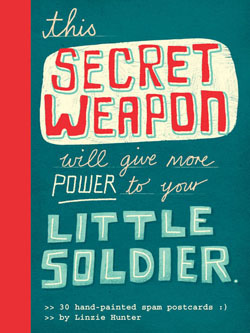
Out any minute now: Linzie Hunter‘s Secret Weapon postcard book: “30 Hand-Painted Spam Postcards.” You no doubt read about Linzie Hunter in this Consumed. The book is supercool.
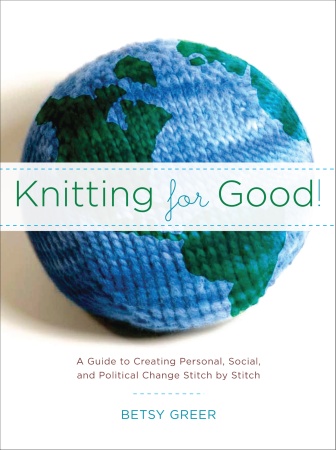
Also coming soon: Betsy Greer’s Knitting For Good. I just got this in the mail and it looks cool, too, though I have not yet read it. Possibly you read a bit about Betsy Greer in Buying In.

And now in its third (!) printing, according to an email blast I received yestersday, there’s the book version of Handmade Nation. I haven’t yet gotten hold of this, but I hear nothing but good about it. And Faythe Levine is, of course, also in Buying In.
I don’t want make too much of this, but it’s interesting that as retail sales and consumer spending have fallen, and, you know, media coverage of the economy has basically devolved into one extended freakout, Etsy says its sales have continued to rise.
- $7.93 million of goods sold — a 5% increase over August.
- That represents 544,157 items sold, a 5.3% increase from August’s stats.
Interesting. Etsy’s not exactly positioned as a bargain-hunting site. Maybe all it means is that its in a growth phase, being still relatively small, that would be pronounced in a more optimistic economy. Or maybe it means that “handmade” stuff is holding onto value in consumer minds that more mass goods are not holding onto.
The latter theory reminds me of something I read the other day on the Greenjeans blog, which asked, “Is ‘handwashing’ the new greewashing?” Basically this refers to making stuff look handmade.
I wonder if I didn’t see a hint of the next big marketing trend today on the cover of the graphic design magazine HOW: “Incorporating Handmade Elements.” They actually call it “Design 2.0” suggesting the techie look is out and the handmade look is in.
Greenjeans’ Amy Shaw continues:
I think perhaps because handmade makes us feel safe, and makes huge corporations seem kinder and gentler. And in today’s struggling economy, those companies that can make consumers feel warm and fuzzy will have a huge advantage.
Maybe this helps explain Etsy resilience? If so, then perhaps there’s more “handwashing” to come. . .

One of the new embroidery patterns from Sublime Stitching is a tie-in to the forthcoming documentary Handmade Nation. Sublime Stitching is of course the company of Jenny Hart, of the Austin Craft Mafia; Handmade Nation is the film coming out next year, made by Fayth Levine.
Hart is also going to be at Maker Faire in Austin this weekend, along with fellow ACM founder Jennifer Perkins. Details here. Hart, Perkins, and Levine are all in the chapter of Buying In that looks at DIYism etc. Follow-up interviews with Hart and Perkins on this site are here and here. (And one with Tina Sparkles, also an ACM founder who’s in the book, is here.)
I think a promotional tie-in embroidery pattern is a really great idea. Read more
On a brief visit to Portland back in April, I had a chance to stop by a pretty cool show at the Museum of Contemporary Craft, titled “Framing: The Art of Jewelry.” Among the pieces that I found most interesting were some by Harriete Estel Berman, a jewelry maker based in California. So I was really pleasantly surprised when Berman coincidentally contacted me a few months later.
After learning a little more about the breadth of her work, which is consistently fascinating both in terms of her actual mastery of craft and materials, and in terms of its thematic exploration of consumer culture.
I immediately figured she’d be a great Q&A subject here, and after some delays that were entirely my fault, I got some questions together for her. Her answers did not disappoint. And here (after another delay that was again my fault) they are. Read on for Berman’s thoughts on advertising language, on where she gets the raw material that she converts into art, about consumer culture and identity, trying to imagine sexy furniture at Ethan Allen, and her take on the impact of Etsy/the DIY scene/the Internet on creators such as herself, so far.
[Plus: It happens that she also has work at a show that opened more recently at the Museum of Contemporary Craft, called Manuf®actured: The Conspicuous Transformation of Everyday Objects, which is up through January 4, 2009 and sounds pretty interesting.]
Q: We’ve been in touch for a while, and I’ve wanted to do this Q&A for a while, but part of what’s slowed me down is that you’ve done so much interesting work and I don’t know where to start. So I’m actually going to start at the end. What are you working on right now — and how does it fit into the general themes you’ve been exploring since (I think I have this right but correct me if not) about 1980.
A: Usually, I am working on several different pieces at the same time, all at different stages of progress. Generally, this is a necessity, as ideas often gestate for months to years or time is needed to collect the right tin cans for a specific idea.

Currently, I am in the middle of a series of work called, Bermaid, the California Collection. (Image above.) These three-dimensional fruit crate labels and bracelets are constructed from recycled tin cans providing layers of images and symbolism. The images and repurposing of post consumer material to construct the fruit crate labels and bracelets reflect upon California as both the archetypal consumer culture and a leader in the recycling movement and green design. Read more
Tomorrow (Thursday) night, I’ll be very briefly in New York for an American Craft Council panel called The Politics of Craft. This is not an advertisement for myself, as the main attractions are Sabrina Gschwandtner, of KnitKnit, and Liz Collins, knitwear designer and founder of Knitting Nation. I expect both will be very interesting and I’m looking forward to meeting them. I’m simply the moderator.
The real reason I bring this up is to apologize in advance to friends in NY: I will not be seeing any of you. I’m literally just there for the night and leaving very early the next morning. So if you happen to hear about this event and wonder why I’m in town without calling, that is the reason. Catch you next time?
UPDATE 9/24: Here is a link to audio recording of this event, if you are curious.
For those of you who read this past weekend’s Consumed about the changing motivations of scrapbookers over time, here’s a follow up: Scrap Smack asks its readers who they scrap for: Do you scrap for relaxation, the creative process, the pure enjoyment of it? Or do you scrap for other reasons? For yourself, for your family, for future generations, for business?”
I scrap for myself, but I must admit when my children drag out their books to show their friends I am proud. I am proud that they want to show their friends what Mommy has done. I am proud when I receive compliments, after all it’s only human to want recognition for a job well done and for talents you may have.
Scrap Smack posts always get a lot of comments, and they’re piling up fast at this one.
 SHARED MEMORIES:
SHARED MEMORIES:
The urge to have your creative talent for recording the past recognized in the here and now
This week in Consumed, a look at scrapbooking, and how scrapbookers’ creations (and their motives) have evolved.
Many of the images reproduced in “Scrapbooks: An American History,” by Jessica Helfand, date back 50, 80, even 100 years. Reproduced in color and spread across wide pages, they are treated as worthy examples of creativity. The anonymous scrapbook creators could hardly have imagined such a fate for their work. Whatever audience they had in mind, it surely did not include a design critic ruminating over this “evocative” and “largely overlooked class of artifact.”
In the 21st century, of course, scrapbooking is a multibillion-dollar affair, with specialty publications and businesses serving a huge market of self-documentarians. By and large, their work has little aesthetic resemblance to what Helfand has compiled. And while contemporary “scrappers” may not be thinking about future historians, a good number are thinking about an audience — and it isn’t just the grandkids. …
Read the column in the September 14, 2008, issue if The New York Times Magazine, or here.
Consumed archive is here, and FAQ is here. The Times’ Consumed RSS feed is here. Consumed Facebook page is here.
To make a point about Consumed that you think readers of The Times Magazine would be interested in: “Letters should be addressed to Letters to the Editor, Magazine, The New York Times, 620 Eighth Avenue, 6th Floor, New York, N.Y. 10018. The e-mail address is magazine@nytimes.com. All letters should include the writer’s name, address and daytime telephone number. We are unable to acknowledge or return unpublished letters. Letters may be edited for length and clarity.”
Save
Here, then, the third Q&A connected to artists I commissioned to create posters related to Buying In. This time it’s The Little Friends of Printmaking, who I believe I first heard of from Faythe Levine; then I checked out their site, and saw their work in person when I happened to be at Renegade Chicago a year or so ago. I was thrilled when they zithromax were willing to make a poster in connection with the Washington D.C. Buying In event (see below; there’s also a version of this poster that’s sort of like a “tour blank,” but more on that some other time).
As with F2 Design and Amy Jo, the other esteemed creators I was fortunate to enlist in my largely ego-driven cause, I asked The Little Friends of Printmaking if they’d be willing to do a Q&A here, and they said yes. Read on for their thoughts on working as a team; on getting applications from hopeful Brand Managers; on the inspiring effects of crippling student debt and no particular professional prospects; on the effect of so many poster-makers; on how their life is actually not that much like a sitcom; and on which of their cats is less helpful, among other topics.
Very briefly: The Little Friends of Printmaking are Melissa and JW Buchanan; they are based in Milwaukee; they make posters and art prints and illustration work and apparently even at least one toy. (Blog; Flickr stream.) And as you’ll see, they’re very funny.

Q: So you are a married couple who work together as Little Friends of Printmaking. At what point did you decide to take a team approach? And do you think it made it harder or easier to establish yourselves as Little Friends of Printmaking than as two separate artists? Do people ever think that you’re more of a company than two collaborating artists?
Melissa: We started working together when we were in school. We were both studying art at the University of Wisconsin in Madison, and we had met early on. I don’t know when exactly we started to work as a team, or if there was a specific project that made us want to pool our resources; I think it was a gradual extension of us working side by side. When you’re a printmaker the work goes much faster if you’re working with a buddy. That kind of relationship, where you help someone else print their work, that wasn’t unusual. What we did, collaborating from beginning to end, was unusual. Our professors didn’t really encourage us or even approve of our partnership, probably because it was harder to grade us as individuals. We made their lives 0.15% more complicated, which of course was unacceptable.
JW: It’s a big step to throw everything together into a partnership the way we did. Maybe we didn’t have the sense of propriety that other people had for their own work, or maybe we just liked each other’s work a whole lot. Who knows. As a team, we have had an easier time establishing ourselves in some respects. When you work under a name that isn’t your given name, or from under the umbrella of a collective, you kind of get to invent and define who you are as an artist without sounding too much like an idiot or an asshole.
It’s been much easier for us to promote our Little Friends projects because our names aren’t front and center. I don’t think we would have made it very far if we had to rely on reserves of self-confidence that we don’t have. We can hide behind the name, use it as a bully pulpit, whatever. It works for us. There’s still a lot of glamour attached to the idea of the artist as a genius with a singular vision—we don’t get any of that. We’re glamour-deficient. Read more
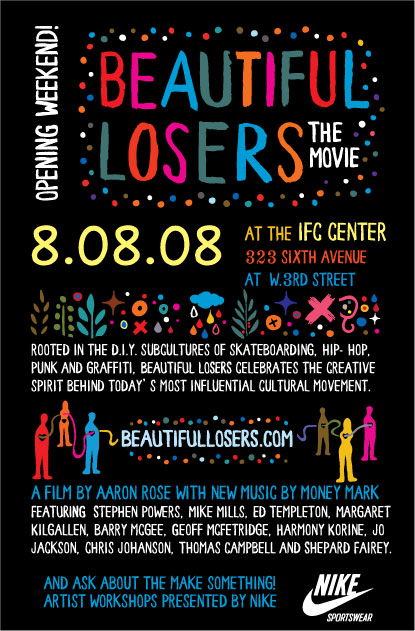
I’m happy that the Beautiful Losers documentary is getting plenty of attention, and I look forward to seeing it. I’m a fan of many of the artists who I gather are in it, and I both like and respect Aaron Rose. He is interviewed in the current issue of Complex talking about a spinoff project: “Make Something!! Workshops,” and I like the sound of these, too. The film’s site says:
Working with public school art programs and youth mentoring programs, MAKE SOMETHING!! will invite local children to participate in creative workshops such as sign painting, photography, skateboard graphic design, toy design, filmmaking, tattoo art, footwear design and zine making.
Workshops will be hosted by renowned artists from the Beautiful Losers “do-it-yourself” art subculture, which include Ed Templeton, Tobin Yelland, Geoff McFetridge, Shepard Fairey, Mike Mills, Todd James, Cheryl Dunn, Kaws, Mr. Cartoon and Aaron Rose. The work created in each location will form a continually evolving exhibition, which will be open to the public to view.
Sounds good.
And yet … despite all my good vibes about this … I must say that my reaction to the version of the movie poster above was: What’s the swoosh doing on there?
These workshops, apparently, are courtesy of Nike. Was that really necessary? “Make something” is obviously a fine message — but to me the whole idea of doing-it-yourself kind of loses its oomph if the doing has to happen under the auspices of the almighty swoosh. After all, did the various artists and creators celebrated in the film have to rely on a multinational to learn to express themselves? I think not. On the film’s site, the tab for this project is simply “Nike Workshops.” Ew.
I think this a bad move on Nike’s part — if Swoosh Inc. wants to do something good for the kids, then just do it (to borrow a phrase) and for once keep your logo to yourself.
I also just think it’s, you know, a general all-around bummer.
Not that any of this will stop me from seeing the doc. In fact I wish I could make it to the U.S. premier, in New York City, tonight.
Oh, and I meant to mention this earlier: Robert Kalin, who you may recall from the Handmade 2.0 article (and/or from Buying In), has moved from CEO to chairman and Chief Creative Officer at Etsy.
This comes around six months earlier than I might have guessed, but I don’t think it’s a surprise — and I suspect it’s a good thing for all concerned. It’s certainly not unusual for a founder to conclude that s/he doesn’t really want to remain CEO as a startup grows. But very often coming to that realization takes too long — or, worse, never comes, and the person is forced out.
I don’t know anything about Maria Thomas, the new CEO. So with that significant caveat, I would guess this is a good thing for the company, and for Kalin as well. (I haven’t talked to him or anybody at Etsy about this. If I do and hear anything interesting, will pass it along.)
Here’s the NYT item about it, including Kalin’s nail-polish choice for making the announcement. Earlier Silicon Alley Insider item here. Etsy VC backer here; Kalin post here.

This took me by surprise, but I guess it shouldn’t have: The latest Sublime Stitching artist collaborator is none other than The Black Apple. In other words: Black Apple embroidery patterns.
Sublime Stitching of course is Jenny Hart’s company — Hart being part of the Austin Craft Mafia, and a figure in Buying In. (Post-Buying In follow-up Q&A with Hart is here.)
And The Black Apple is Emily Martin, who dedicated readers will recall from the Handmade 2.0 article as (I think this is still true) the single most popular seller on Etsy.
Both Hart & Martin are very talented and very smart — and, if you don’t mind my saying so, incredibly nice. I did not know they were acquainted, but I think it’s great they’re working together; it makes a lot of sense.
Details here and here.




 "
"






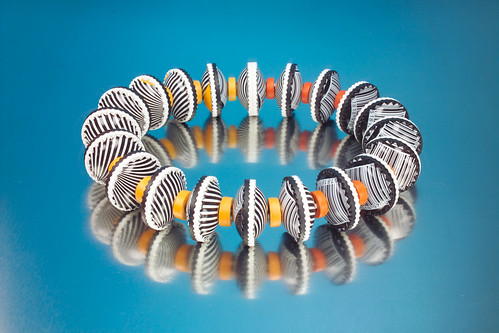

 SHARED MEMORIES:
SHARED MEMORIES:















 Kim Fellner's book
Kim Fellner's book  A
A